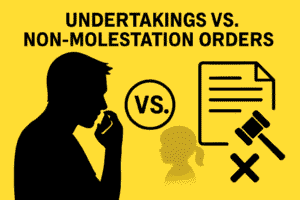A Scott Schedule is one of the most important documents you may have to prepare or respond to in family court. Used in Fact-Finding hearings, it sets out allegations clearly for the judge to consider. Getting this wrong can weaken your position – but done properly, it brings clarity to your case. This guide explains what a Scott Schedule is, shows you a real example, and walks you through how to prepare or respond effectively.
🔑 Key Takeaways
- A Scott Schedule is a table used in family court fact-finding hearings to set out allegations, responses, and evidence clearly.
- It keeps cases focused, speeds up hearings, and ensures both parties can respond fairly.
- Courts usually limit the number of allegations – keep entries brief, dated, and evidence-backed.
- If allegations are against you, respond with “Admit” or “Deny” and reference supporting evidence.
- Strong schedules rely on concise wording, correct formatting, and supporting documents like witness statements or reports.
Need help structuring your Scott Schedule so it makes sense to the judge? Message us on WhatsApp for expert support.
Quick Navigation:
What is a Scott Schedule?
A Scott Schedule is a table used in family court to present allegations of harm or misconduct in a structured way. It lists each allegation, the date it allegedly happened, references to evidence, the other party’s response, and finally the judge’s findings.
📌 Did you know? The name comes from the case Scott v London Dock Co (1837), where a judge ordered this format to make complex disputes easier to understand.
For family law, the schedule usually covers allegations of domestic abuse, coercive control, or safeguarding concerns that need to be decided at a Fact-Finding hearing.
Why the Court Uses Them
Scott Schedules aren’t just paperwork – they are designed to keep hearings focused and fair. By setting out allegations side by side with responses, they give judges a clear snapshot of what’s in dispute and what evidence matters most.
- Keeps the focus on key allegations rather than broad accusations.
- Helps CAFCASS and the judge see evidence in a clear format.
- Speeds up hearings by narrowing disputes.
- Ensures both parties have a fair chance to admit, deny, or explain allegations.
👉 Before you can even apply for a Child Arrangements Order (using the C100 form), most dads are required to attend a MIAM – a Mediation Information & Assessment Meeting. This step shows the court you’ve tried to resolve matters without going straight to court. Only later in the case, if allegations need to be tested, will the judge direct a Scott Schedule for the fact-finding hearing.
Scott Schedule Example (Free Template)
Here’s a simplified example of a Scott Schedule:
| Allegation No. | Date of Incident | Allegation Description | Reference | Response | Judge’s Finding |
|---|---|---|---|---|---|
| 1 | 12/03/2023 | Physical assault | W1, E1 | ❌ Deny | [Blank] |
| 2 | 20/04/2023 | Verbal abuse | W2 | ✅ Admit | [Blank] |
| 3 | 01/05/2023 | Financial control | W3, E2 | ❌ Deny | [Blank] |
This format may vary slightly between courts, but the principle remains the same: keep it brief, factual, and well-referenced.
How to Prepare Your Own (If You’re Making Allegations)
If the court has asked you to prepare a Scott Schedule:
- Number each allegation clearly – no long paragraphs.
- Include dates – even if approximate.
- Keep it factual – avoid opinions or emotional language.
- Reference supporting evidence – like witness statements or police reports.
- Leave response/judge columns blank – those will be filled by the other party and the court.
💡 Tip: Use your Position Statement support to expand on the detail behind each allegation.
If you’re also at the application stage, our C100 Form Support service ensures your application and Scott Schedule work together strategically.
How to Respond to a Scott Schedule (If Allegations Are Against You)
If you’re the one responding:
- Be concise – simply “Admit” or “Deny” each allegation.
- Add references – point to evidence (texts, witness statements) where relevant.
- Stay child-focused – frame your response around what is best for your child, not attacking the other parent.
- Avoid emotional language – judges want facts, not arguments.
📌 If you’ve been served a schedule of allegations, our Non-Molestation & Allegations Defence service provides professional support in structuring your responses.
Served with a Scott Schedule? WhatsApp us today and we’ll help you draft strong, factual responses.
Evidence That Strengthens a Scott Schedule
Examples of evidence that can be referenced:
- Police or incident reports
- GP or hospital records
- CAFCASS safeguarding letters or Section 7 reports
- School reports or teacher statements
- Screenshots of texts, emails, or social media posts
Your CAFCASS safeguarding call often shapes what ends up in the Scott Schedule – our specialist call preparation helps you prepare effectively from the very start.
If your case also involves a Section 7 assessment, our CAFCASS Section 7 report support ensures you’re ready for the officer’s recommendations.
Common Mistakes to Avoid
Even strong cases can be undermined by basic errors. Here are the pitfalls dads most often fall into when preparing or responding to a Scott Schedule:
- Writing long, emotional paragraphs instead of bullet points.
- Including too many allegations (courts often cap the number).
- Missing dates or failing to reference evidence.
- Over-explaining when responding – keep it factual.
Don’t let avoidable mistakes damage your case — WhatsApp us now for professional guidance.
FAQs
When you’re researching Scott Schedules online, the same questions come up again and again. Here are the answers dads most often look for:
What is a Scott Schedule in family law?
A Scott Schedule is a table the court uses to organise allegations at a Fact-Finding hearing.
How do I prepare a Scott Schedule?
Keep it brief, numbered, and supported with dates and references. Use a Position Statement for extra detail.
How do I respond to a Scott Schedule?
Keep answers short: admit or deny. Add evidence references where relevant. Avoid emotional responses.
Can I get a Scott Schedule template?
Yes – we provide a free downloadable Word template so you can structure your schedule correctly.
What happens after I submit a Scott Schedule?
The judge reviews it at the Fact-Finding hearing, considers the evidence, and records findings in the final column.
Need Help Preparing or Responding?
Getting your Scott Schedule right can make or break your case. At Dads Consultancy, we support fathers through every stage of family court. From drafting schedules to preparing statements and responses, we ensure your case is clear, strategic, and child-focused.
Our Child Arrangements Order support covers every stage, including Scott Schedules, witness statements, and hearings – with full McKenzie Friend court support if your case proceeds to a hearing.
✅ Related Reading
- Fact-Finding Hearing in Family Court – Step by Step Guide
- How Judge’s Findings Shape Your Case
- Witness Statement for Family Law Court – Drafting a Compelling One
- Family Court Position Statement – Writing a Compelling One
🧠 Insider Insight: Lach, our founder, is a qualified social worker who used to write Section 7 reports for CAFCASS – the very reports that influence court outcomes. Now he helps dads respond to them. Learn more about Lach’s background.




